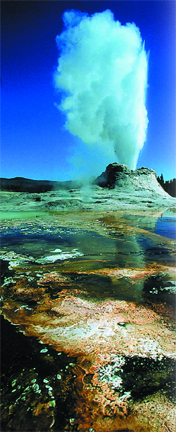 On Nov. 3, 2002,
Alaska’s Denali fault ruptured, causing a magnitude-7.9 earthquake. Within
less than an hour, surface waves rolled through Yellowstone National Park, about
1,900 miles to the southeast, triggering more than 250 smaller-magnitude quakes
over the next 24 hours — and altering the eruption behavior of many of
the park’s famed geysers.
On Nov. 3, 2002,
Alaska’s Denali fault ruptured, causing a magnitude-7.9 earthquake. Within
less than an hour, surface waves rolled through Yellowstone National Park, about
1,900 miles to the southeast, triggering more than 250 smaller-magnitude quakes
over the next 24 hours — and altering the eruption behavior of many of
the park’s famed geysers.Castle Geyser at Yellowstone National Park, Wyo., erupted less frequently after seismic waves from the Denali earthquake almost 2,000 miles away in Alaska moved through Yellowstone in November 2002. Scientists say that the hydrothermal activity is connected to the far-reaching seismic effects. Image courtesy Stephan Husen, University of Utah.
The fact that small earthquakes often occur in areas with hydrothermal activity shortly after larger quakes has led scientists to theorize that high-pressure fluids in the crust are one mechanism behind the phenomenon, called remotely triggered seismicity. Until now, however, no solid evidence had been found to connect triggered seismicity and hydrothermal activity. “Nobody has been able to prove that fluids are the culprit,” says Stephanie Prejean, a seismologist with the U.S. Geological Survey at the Alaska Volcano Observatory in Anchorage.
Seismologist Stephan Husen, currently at the Swiss Seismological Survey of the Swiss Federal Institute of Technology in Zurich, and colleagues from the University of Utah and the National Park Service make that connection in the June Geology. The altered behavior of multiple geysers across Yellowstone, accompanied by the unusual occurrence of simultaneous earthquake swarms at different geyser basins, strongly suggests triggered seismicity as a result of changes in fluid pressure, the authors write.
“The great thing about the Yellowstone case after Denali,” Prejean says, “is that they do see changes in the hydrothermal system at the same time that the triggered earthquakes are happening; it’s very good evidence that they are in fact linked.”
Yellowstone National Park, spread across the states of Montana, Idaho and Wyoming, is home to some 10,000 geysers, hot springs and fumaroles. As the surface waves from Denali passed by Yellowstone’s 100 Spring Plain (a hot spring system in Norris Geyser Basin), several small springs begin to boil and erupt, spurting water up to a meter out of the ground. Other normally clear springs became muddy and turbid, Husen’s team reported.
Within hours, many geysers experienced either an increase or decrease in their eruption intervals. Of the 22 that researchers were monitoring, eight displayed perceptible changes: Five began erupting more frequently, and three began erupting less frequently. Why some erupted more and others less may be explained by the jarring loose of minerals that had been clogging channels, the researchers say. In some cases, this would have opened more steam conduits, thus increasing local permeability and, consequently, the frequency of eruptions. In other cases, it would have widened the channels, thus decreasing the pressure and slowing the eruptions.
The changes observed during and after the quake lasted from just hours or days up to several weeks. Lone Pine Geyser in the West Thumb Geyser Basin, for example, had a gradually increasing eruption interval — it erupted less and less frequently, until it peaked three weeks after the earthquake. Hundreds of tiny earthquakes continued to occur in the week after the Denali quake, but then seismic activity within the park returned to normal levels after 30 days.
The Denali event is not the first time in history such events have occurred at Yellowstone. “The 1959 earthquake at Hebgen Lake caused many changes to the hydrothermal features at Yellowstone, but it was a fairly local earthquake,” says geophysicist Jake Lowenstern, scientist-in-charge at the Yellowstone Volcano Observatory.
Although scientists had observed that earthquakes like Hebgen Lake triggered smaller quakes and altered hydrothermal activity near the epicenter, they did not believe that earthquakes could trigger distant seismicity until 1992. That year, a magnitude-7.3 earthquake occurred in the Mojave Desert near Landers, Calif., and triggered smaller quakes in geothermal areas all over the western United States, including 800 miles away in Yellowstone.
The 2002 Denali quake, however, surpassed all others in activating quakes at great distances. “It’s just a spectacular example of triggered seismicity,” Lowenstern says.

